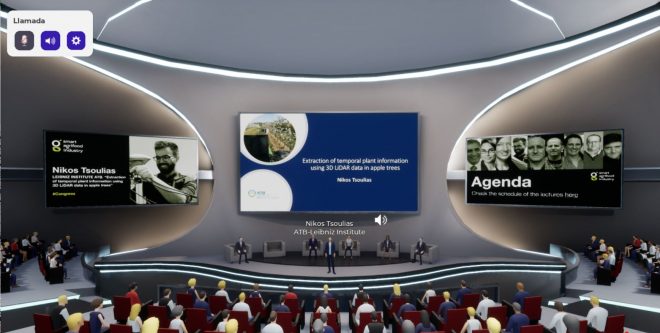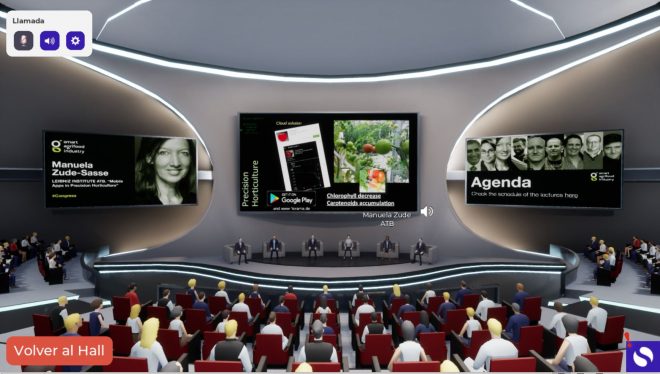Summary of the presentations
Smart Agrifood Industry | Second Day
|
|
|
|
|
|
|
The second block of the Smart Agrifood Industry Congress has been a great opportunity to meet the AgriPhotonics ZIM Network partners and to listen to experts from the agtech and foodtech fields.
|
|
|
|
"Introduction AgriPhotonics ZIM Network" Janina Bolling | OpTecBB & Shlomo Glazer | Photonics Israel
|
|
|
|
The AgriPhotonics ZIM Network connects German and Israeli organisations that collect data of plant material for knowledge-based and sustainable plant production using optical methods and photonic technologies. |
|
|
|
"Extraction of temporal plant information using 3D LiDAR data in apple trees" Nikos Tsoulias | Leibniz Institute of Agricultural Engineering and Bio-economy |
|
|
|
During his speech "Extraction of temporal plant information using 3D LiDAR data in apple trees", Nikos Tsoulias has explained that the implementation of geometric and radiometric features in three-dimensional space analysis can improve the fruit detection. In this study, a light detection and range LiDAR system was used to scan apple trees before and after defoliation, four times during seasonal tree growth. And the conclusion of the study points to the high capacity of LiDAR variables to localize fruit and estimate its size by means of remote sensing. |
|
|
|
"Mobile Apps in Precision Horticulture" Manuela Zude-Sasse | Leibniz Institute of Agricultural Engineering and Bio-economy |
|
|
|
Manuela Zude-Sasse has presented several Mobile Apps for Precision Horticulture that, combined with site-specific technologies like sensors or drones, may have applications such as planning the best harvest date, mapping the soluble solids content in citrus, chlorophyll decrease or carotenoids accumulation. Since many horticultural crops are in small fields in the major part of the world, Manuela has also pointed out that site-specific technologies should be developed and they must be economically viable and easy for small farmers to adopt. |
|
|
|
"CNN algorithm for single and overall weight estimation of melons using UAV images"
Dr. Iftach Klapp | ARO Volcani Center |
|
|
|
Dr. Iftach Klapp has explained how his team has developed a robust algorithm that detects melons in an agricultural environment using UAV images for yield estimation.
The CNN algorithm based system includes three main stages: melon detection, feature extraction, yield estimation and has provided promising results. |
|
|
|
"The Volcani Institute – Research activities in postharvest technologies and food science" Dr. Ron Porat | ARO Volcani Center |
|
|
|
Ron Porat has described some of the research activities conducted in Volcani Institute. At the Dept. of Postharvest Science, the research areas are: ripening and senescence, postharvest decay control, chilling stress, sensory and nutritional quality. The research areas of the Dept. of Food Science include: chemical and microbial food safety, agronanotechnology measures for smart packaging, grain storage, health and nutritious foods.
|
|
|
|
"Optical methods for the agricultural and food industry" Claudia Pacholski | University of Potsdam |
|
|
|
Light technologies for process analytics in food industry can be used for determining the concentration or the particle size of the elements. Some use cases are enzyme induced gelling in cheese production, the mashing process of beer, or inline characterisation of high cell density fermentation. On the other hand, the application of biosensors and fibre optics in the agrifood value chain can be also used to study the degradation of microplastic in soil -and its subsequent entry into the food chain-, by analysing the composition of soil wit IR spectroscopy.
|
|
|
|
"Remote sensing of plant physiology – an intersection of machine learning, remote sensing and photosynthesis" Oded Liran | MIGAL Galilee Research Institute |
|
|
|
The NDVI index was originally invented to track seasonal changes in vegetation satellites images, but it is not accurate when it comes to address agricultural challenges. And this is where plant physiology comes in. A discipline which studies chemical reactions that change with time like photosynthesis, germination, transpiration or ripening. However, outside a controlled environment measurements are getting tricky and it requires the intervention of technologies like remote sensing spectroscopy, chemometrics, machine learning or data science. The group of Agrophysics studies of the MIGAL Galilee Research Institue, is focused in the application of machine learning and remote sensing to monitor plant physiology to enable a better Precision Agriculture. |
|
|
|
"Spectral Imaging in the Food Processing Industry" Valentin Regir | LLA Instruments GmbH & Co. KG |
|
|
|
|
Valentin Regir has presented a push-broom type of spectral cameras designed by LLA Instruments and a control software and calibration model development. Today’s demands in quality and safety within the food processing industries result in increasing numbers of applications, of which a selection is highlighted, utilizing spectral imaging as innovative, high-end technology.
|
|
|
|
|
C/ Milà i Fontanals 14-26, 1º-6ª · 08012 BARCELONA España · Tel. (+34) 93 783 36 64 · info@secpho.org
You are subscribed to secpho news with this email address [ ]. If you wish, you can unsubscribe here at any time. © 2021 secpho. All rights reserved.
|
|
| |
|
|









